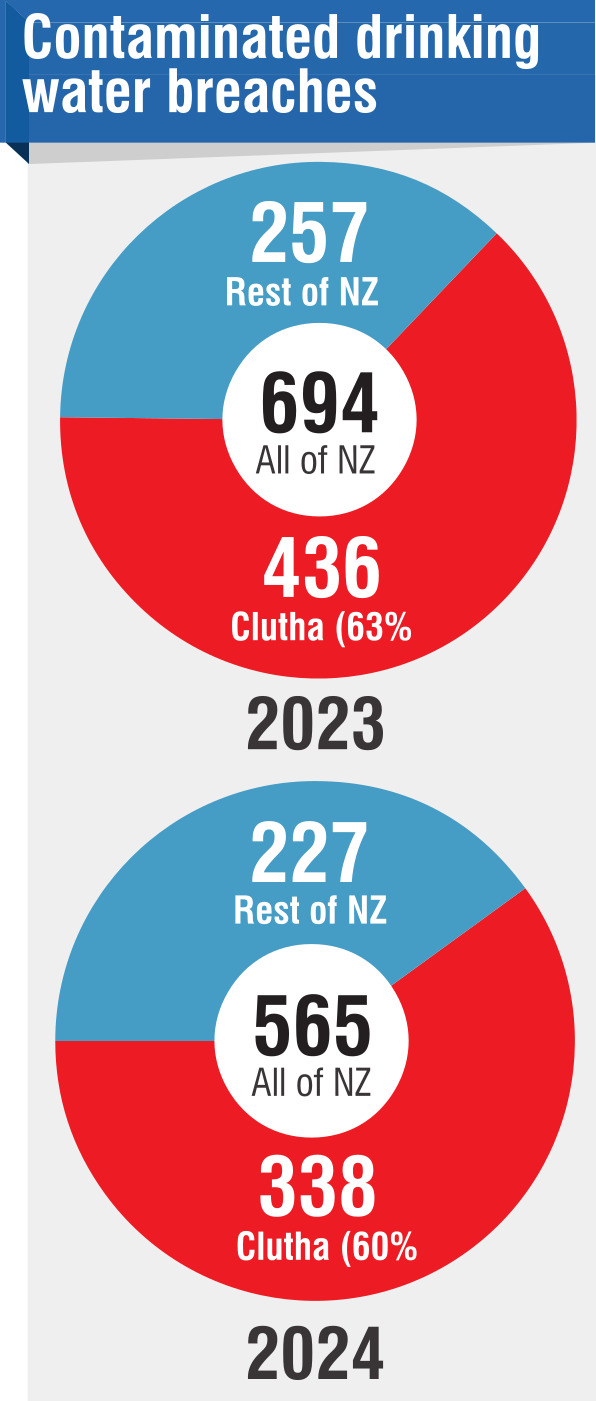
The Water Services Authority report, publicly released yesterday, said it received 565 notifications in 2024 that drinking water was, or might be, unsafe.
Clutha District Council was responsible for 338, or 59.8%, of the country’s drinking water quality breaches.
Mayor Bryan Cadogan said yesterday he could not ignore the report’s findings.
"They’re embarrassing."
The supply with the most E. coli notifications was Waitahuna Rural (24), which is owned by Clutha District Council and is on a permanent boil-water notice.
In March 2023, the authority issued a direction to Clutha in response to aluminium levels breaching standards across five of the council’s supplies.
In January 2025, the council met the remaining requirements of the compliance order.

"So, in the 1970s, Clutha developed the most extensive water scheme in New Zealand for our size. We’re the third-longest in New Zealand. It is Auckland, Christchurch, then Clutha.
"So, what we’ve done is we’ve set up a council-run extensive water system supplying to virtually all our rural and all our towns. No-one else does it.
"But the problem with that for us is that when you have council-run schemes, you have consent and you have to abide."
The water supply was built for 1.2 million stock units across all the towns.
"Unfortunately, that’s a real problem now that system is no longer compliant with the New Zealand Water Standards.
"The scheme was not only working 100% the way it was meant to, it’s producing better water now than it has in all its lifetimes.
"But unfortunately, it’s like trying to turn a car into an aeroplane."
It was only relatively recently the council started addressing the problems, Mr Cadogan said.
"That’s why our debt [has increased], because our council had no debt only five years ago.
"We’ve got 150-odd-million dollars of debt and all the water plants that we’ve upgraded are about to be commissioned."
Back in the 1970s, the government funded 50% of Clutha’s new drinking water system, and struck similar deals with other councils, he said.
In contrast, Clutha had needed to pay for all of the upgrades this time, Mr Cadogan said.
"And that’s why I am horrified at the rate rises that are coming through."
"We’re stuck with this dichotomy of having the third-longest water recirculation network in New Zealand behind Auckland and Christchurch ... and a population of 19,000."
Water Authority head of operations Steve Taylor said it had been working with Clutha District Council to make improvements.
"From the outset, Clutha District Council was open to engaging with the authority, sharing information, being honest about their challenges and responding to the directives issued by the authority.
"It should also be noted that this report is for the year to December 2024 and considerable work has been completed by the council in the past six months.
"We will continue to work closely with Clutha District Council as it addresses issues across its supplies."
Clutha District had 13 distinct communities, all with water and sewage, Mr Cadogan said.
"Within those 13 communities, there’s 27 either water or sewage plants.
"If you’ve got 30-year consent, that means you’re doing up at least 27 plants over 30 years. You’re basically doing up one a year."
Each of those upgrades were in the vicinity of $5m to $20m, he said.
Although the authority’s report was tough reading, it noted there had been some improvement on last year — Clutha had 98 fewer breaches in 2024.
"You just keep on going. It is never-ending.
"So, the environmental expectations and the financial capacity and ability for communities like Clutha is really going to test people’s ability to pay like never before."











